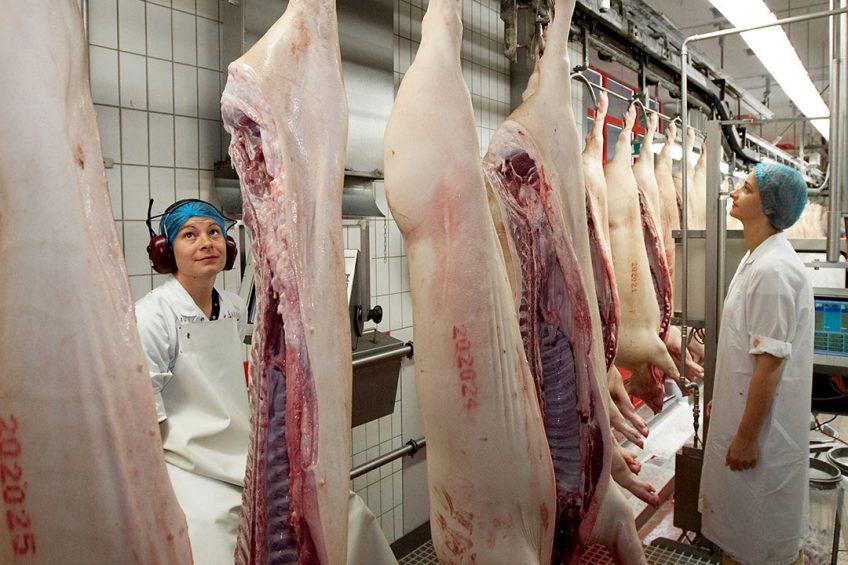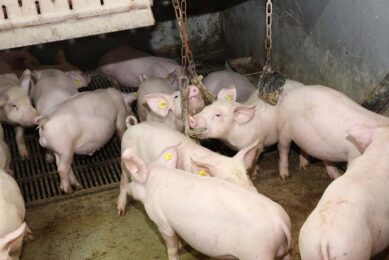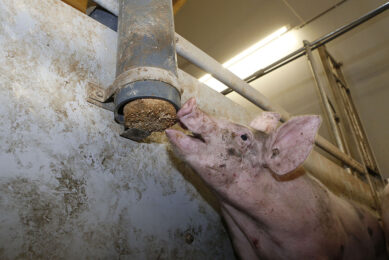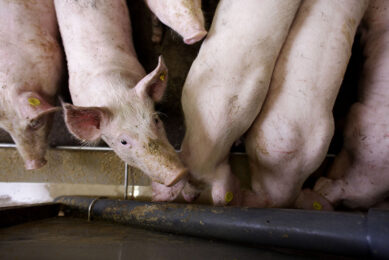Using meat inspection data for better pig welfare

The analysis of meat inspection data at slaughter suggests availability of genetic variation for most common indicators of poor animal welfare. That way, genetic selection can be a tool in reducing the risk of diseases, thereby reducing pain and suffering of animals.
Meat inspection data along with the genetic selection for economically important production traits can be used to enhance animal welfare, so much became clear from a recent publication in the peer-reviewed journal Animals. Researchers from breeding company Topigs Norsvin and Wageningen University & Research, the Netherlands, delved deeper into this topic*. The article was published in early 2018.
The researchers wrote that in many slaughter plants, animal health and welfare are monitored during meat inspection at slaughter. Carcasses are usually examined by meat inspectors and remarks are made with respect to different diseases, injuries and other abnormalities. Those data are also valuable for disease prevention and enhancing animal welfare but are rarely used for that purpose. The researchers therefore set up the following trial.
The trial
The scientists analysed data on carcass slaughter remarks of 140,375 finisher pigs to investigate the possibility of genetic selection to reduce the risk of the most prevalent diseases and indicators of sub-optimal animal welfare. These pigs came from slaughter plants in Germany, between 2011 and 2016. The animals came from 13 farms in Germany and the Netherlands, and were given the names ‘Farm A’ until ‘Farm M’.
The researchers also examined effects of non-genetic factors such as differences between farms, sexes and growth rates. The most frequent slaughter remarks were pneumonia (15.4%), joint disorders (9.8%), pleuritis (4.7%), pericarditis (2.3%) and liver lesions (2.2%). Pedigree records were available; those data the team used for genetic analysis.

Find out all there is to know about pig health using Pig Progress’ unique Pig Health Tool
Animal welfare disorders
In total, the research team analysed 5 conditions as indicators of poor health and sub-optimal animal welfare.
- Pneumonia: An inflammation of the tissues of the lungs. It is mainly caused by viruses, bacteria, or fungi.
- Pleuritis: Inflammation of the tissue layers (pleura) lining the lungs and inner chest wall. It causes breathing difficulties for pigs.
- Pericarditis: Inflammation of the pericardium, the fibrous sac surrounding the heart; this sac holds the heart in place to maintain its proper functioning.
- Liver lesions: Liver lesions are mainly caused by parasitic infections. White spots, also called milk spots, are observed in the liver of affected pigs.
- Joint disorders: This includes bursitis and other disorders leading to inflammation of joints. The bursa is a sac filled with lubricating fluid, located between bone, muscle, tendons, and skin to decrease rubbing, friction and irritation. Joint disorders cause pain and difficulty in walking for the animal, indicating poor animal health and welfare.
Trial results
The researchers found that differences exist between farms with respect to the incidences of the slaughter remarks observed at the slaughter plant. Those differences might help to understand the predisposition of pigs to certain health or welfare disorders.
In the study, pneumonia and joint disorders had highest incidences, the researchers wrote in their article. Comparing farms with highest number of pigs, ‘Farm L’ with slower growth rate had higher average incidence for joint disorder (13.1%) than ‘Farm M’ (6.1%) which had a faster growth rate, see Table 1. That might suggest that leaner pigs could have higher joint disorders as will be discussed under the section of ‘genetic correlations with production traits’.
Differences between sexes
The researchers found that the effects of sex were significant (shown by different letters above the bars in Figure 1) for all traits except pneumonia. The joint disorders were found to be highest in males, followed by castrates and females. They observed a similar pattern observed with respect to presence or absence of any of the remarks, mainly due to the pattern of joint disorders among the sexes.
Figure 1 – Incidences (%) of different remarks in different sexes.

Slaughter remarks and growth
Figure 2 shows the relationship between slaughter remarks and growth. The results show that fast growing pigs have fewer incidences of the diseases, therefore leading to less pain and discomfort to the animals. However, results also suggest that the relationship between growth rate and joint disorders is more dependent on farm management. Farms with better management and higher average growth rate could actually have lower incidences of joint disorders. About 42% of the pigs were from ‘Farm L’, that had lower growth rate and highest incidence of joint disorders; this might have contributed to the unexpected association of growth rate and joint disorders.
Figure 2 – Relationship between growth and incidences (%) of different remarks.

Estimates of heritability
The heritability estimates for pneumonia, pleuritis, pericarditis, liver lesions and joint disorders were 0.10, 0.09, 0.14, 0.24, and 0.17, respectively, the researchers wrote. These estimates were considered positive and could therefore be used to bring some improvement in animal welfare, according to the authors.
Genetic correlations with production traits
The research team also made estimates of genetic correlations with different production traits and carcass quality. Most of the correlations were low; in general, these correlations are not expected to be very high as they reflect lesions observed at slaughter mainly due to diseases that are more chronic in nature.
Nevertheless, these lesions are indicative of long term pain and suffering, therefore indicating poor animal welfare, the researchers wrote. The correlations were as expected for pneumonia, pleuritis and pericarditis, but, unexpected for liver lesions. The correlation between growth and overall slaughter remarks was negative, suggesting pigs with faster growth tend to have lower risks associated with these indicators of suboptimal health and welfare.
Creation of a selection index
The results obtained in the study suggest the existence of genetic variation for slaughter remarks and opportunities to reduce their prevalence through genetic selection. As a result, the team developed a selection index for identification of genetically superior boars whose progeny are expected to have a lower risk of unfavourable slaughter remarks. The index was calculated as sum of product of the breeding values with their respective economic weights. The economic values for the slaughter remarks were based on and adapted to the incidences of the slaughter remarks and current prices. This index is used to identify boars that can be used by producers to enhance animal welfare in their pig farms.
The welfare index allows routine genetic evaluations and selection of pigs to reduce the risk of unfavourable slaughter remarks. This is also an example of cooperation along the pork value chain, as efforts from value chain partners is required to enhance animal welfare.
* The original article in Animals was authored by Pramod K. Mathur, Roos Vogelzang and Egbert F. Knol, Topigs Norsvin, the Netherlands; and Herman A. Mulder, Wageningen UR, the Netherlands.
 Beheer
Beheer








 WP Admin
WP Admin  Bewerk bericht
Bewerk bericht